Community Teaching Plan: Health Promotion on Hygiene for Children
VerifiedAdded on 2022/08/25
|7
|1989
|89
Project
AI Summary
This assignment presents a comprehensive community teaching work plan proposal centered around health promotion, with a specific focus on cleanliness, personal hygiene, and the importance of proper handwashing, targeting children aged 5-17 and their families. The proposal outlines the epidemiological rationale, emphasizing the reduction of infection risks and disease spread through handwashing. It includes a detailed teaching plan with nursing diagnoses, readiness for learning assessments, and the application of learning theories. The plan incorporates Healthy People 2020 objectives, behavioral objectives across cognitive, psychomotor, and affective domains, and various teaching strategies such as demonstrations, role-playing, and visual aids. The evaluation of the plan includes assessing knowledge, skills, and behavioral changes through observation, questioning, and activity analysis. Potential barriers to learning are identified, along with strategies to address them, and the presentation incorporates therapeutic communication techniques to engage the audience and facilitate learning. The proposal also highlights the application of creativity in teaching methods to enhance engagement and understanding.
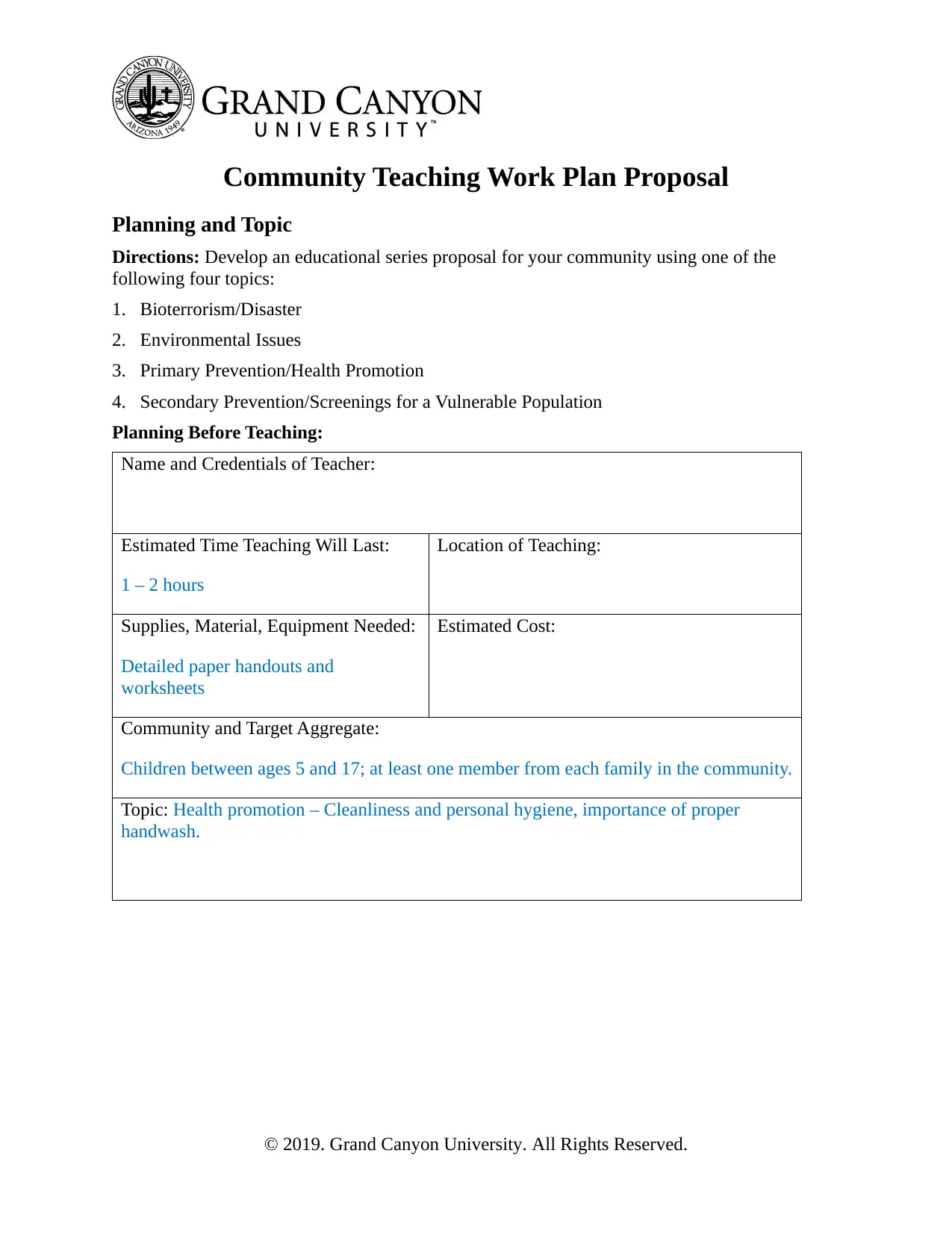
Community Teaching Work Plan Proposal
Planning and Topic
Directions: Develop an educational series proposal for your community using one of the
following four topics:
1. Bioterrorism/Disaster
2. Environmental Issues
3. Primary Prevention/Health Promotion
4. Secondary Prevention/Screenings for a Vulnerable Population
Planning Before Teaching:
Name and Credentials of Teacher:
Estimated Time Teaching Will Last:
1 – 2 hours
Location of Teaching:
Supplies, Material, Equipment Needed:
Detailed paper handouts and
worksheets
Estimated Cost:
Community and Target Aggregate:
Children between ages 5 and 17; at least one member from each family in the community.
Topic: Health promotion – Cleanliness and personal hygiene, importance of proper
handwash.
© 2019. Grand Canyon University. All Rights Reserved.
Planning and Topic
Directions: Develop an educational series proposal for your community using one of the
following four topics:
1. Bioterrorism/Disaster
2. Environmental Issues
3. Primary Prevention/Health Promotion
4. Secondary Prevention/Screenings for a Vulnerable Population
Planning Before Teaching:
Name and Credentials of Teacher:
Estimated Time Teaching Will Last:
1 – 2 hours
Location of Teaching:
Supplies, Material, Equipment Needed:
Detailed paper handouts and
worksheets
Estimated Cost:
Community and Target Aggregate:
Children between ages 5 and 17; at least one member from each family in the community.
Topic: Health promotion – Cleanliness and personal hygiene, importance of proper
handwash.
© 2019. Grand Canyon University. All Rights Reserved.
Paraphrase This Document
Need a fresh take? Get an instant paraphrase of this document with our AI Paraphraser
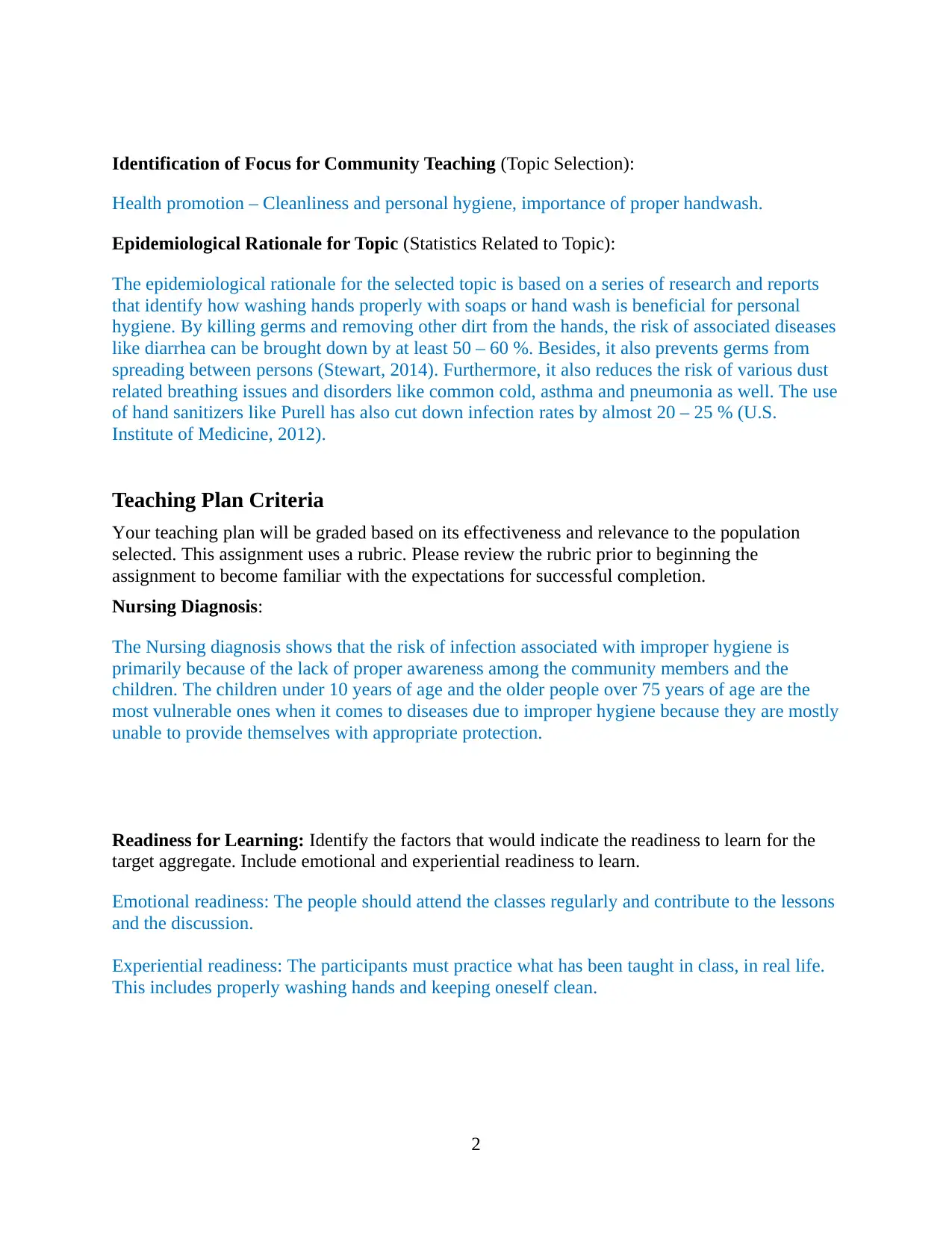
Identification of Focus for Community Teaching (Topic Selection):
Health promotion – Cleanliness and personal hygiene, importance of proper handwash.
Epidemiological Rationale for Topic (Statistics Related to Topic):
The epidemiological rationale for the selected topic is based on a series of research and reports
that identify how washing hands properly with soaps or hand wash is beneficial for personal
hygiene. By killing germs and removing other dirt from the hands, the risk of associated diseases
like diarrhea can be brought down by at least 50 – 60 %. Besides, it also prevents germs from
spreading between persons (Stewart, 2014). Furthermore, it also reduces the risk of various dust
related breathing issues and disorders like common cold, asthma and pneumonia as well. The use
of hand sanitizers like Purell has also cut down infection rates by almost 20 – 25 % (U.S.
Institute of Medicine, 2012).
Teaching Plan Criteria
Your teaching plan will be graded based on its effectiveness and relevance to the population
selected. This assignment uses a rubric. Please review the rubric prior to beginning the
assignment to become familiar with the expectations for successful completion.
Nursing Diagnosis:
The Nursing diagnosis shows that the risk of infection associated with improper hygiene is
primarily because of the lack of proper awareness among the community members and the
children. The children under 10 years of age and the older people over 75 years of age are the
most vulnerable ones when it comes to diseases due to improper hygiene because they are mostly
unable to provide themselves with appropriate protection.
Readiness for Learning: Identify the factors that would indicate the readiness to learn for the
target aggregate. Include emotional and experiential readiness to learn.
Emotional readiness: The people should attend the classes regularly and contribute to the lessons
and the discussion.
Experiential readiness: The participants must practice what has been taught in class, in real life.
This includes properly washing hands and keeping oneself clean.
2
Health promotion – Cleanliness and personal hygiene, importance of proper handwash.
Epidemiological Rationale for Topic (Statistics Related to Topic):
The epidemiological rationale for the selected topic is based on a series of research and reports
that identify how washing hands properly with soaps or hand wash is beneficial for personal
hygiene. By killing germs and removing other dirt from the hands, the risk of associated diseases
like diarrhea can be brought down by at least 50 – 60 %. Besides, it also prevents germs from
spreading between persons (Stewart, 2014). Furthermore, it also reduces the risk of various dust
related breathing issues and disorders like common cold, asthma and pneumonia as well. The use
of hand sanitizers like Purell has also cut down infection rates by almost 20 – 25 % (U.S.
Institute of Medicine, 2012).
Teaching Plan Criteria
Your teaching plan will be graded based on its effectiveness and relevance to the population
selected. This assignment uses a rubric. Please review the rubric prior to beginning the
assignment to become familiar with the expectations for successful completion.
Nursing Diagnosis:
The Nursing diagnosis shows that the risk of infection associated with improper hygiene is
primarily because of the lack of proper awareness among the community members and the
children. The children under 10 years of age and the older people over 75 years of age are the
most vulnerable ones when it comes to diseases due to improper hygiene because they are mostly
unable to provide themselves with appropriate protection.
Readiness for Learning: Identify the factors that would indicate the readiness to learn for the
target aggregate. Include emotional and experiential readiness to learn.
Emotional readiness: The people should attend the classes regularly and contribute to the lessons
and the discussion.
Experiential readiness: The participants must practice what has been taught in class, in real life.
This includes properly washing hands and keeping oneself clean.
2
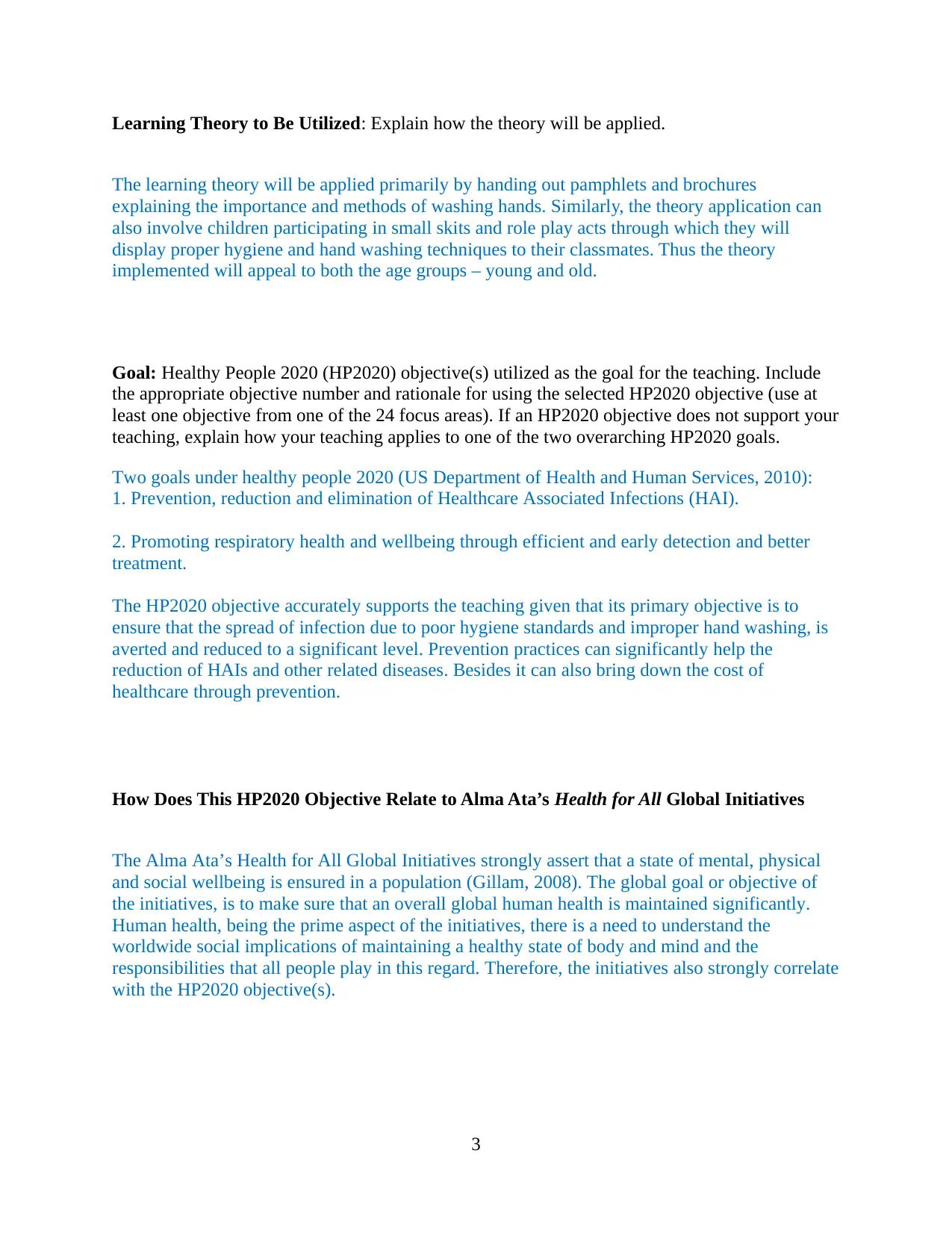
Learning Theory to Be Utilized: Explain how the theory will be applied.
The learning theory will be applied primarily by handing out pamphlets and brochures
explaining the importance and methods of washing hands. Similarly, the theory application can
also involve children participating in small skits and role play acts through which they will
display proper hygiene and hand washing techniques to their classmates. Thus the theory
implemented will appeal to both the age groups – young and old.
Goal: Healthy People 2020 (HP2020) objective(s) utilized as the goal for the teaching. Include
the appropriate objective number and rationale for using the selected HP2020 objective (use at
least one objective from one of the 24 focus areas). If an HP2020 objective does not support your
teaching, explain how your teaching applies to one of the two overarching HP2020 goals.
Two goals under healthy people 2020 (US Department of Health and Human Services, 2010):
1. Prevention, reduction and elimination of Healthcare Associated Infections (HAI).
2. Promoting respiratory health and wellbeing through efficient and early detection and better
treatment.
The HP2020 objective accurately supports the teaching given that its primary objective is to
ensure that the spread of infection due to poor hygiene standards and improper hand washing, is
averted and reduced to a significant level. Prevention practices can significantly help the
reduction of HAIs and other related diseases. Besides it can also bring down the cost of
healthcare through prevention.
How Does This HP2020 Objective Relate to Alma Ata’s Health for All Global Initiatives
The Alma Ata’s Health for All Global Initiatives strongly assert that a state of mental, physical
and social wellbeing is ensured in a population (Gillam, 2008). The global goal or objective of
the initiatives, is to make sure that an overall global human health is maintained significantly.
Human health, being the prime aspect of the initiatives, there is a need to understand the
worldwide social implications of maintaining a healthy state of body and mind and the
responsibilities that all people play in this regard. Therefore, the initiatives also strongly correlate
with the HP2020 objective(s).
3
The learning theory will be applied primarily by handing out pamphlets and brochures
explaining the importance and methods of washing hands. Similarly, the theory application can
also involve children participating in small skits and role play acts through which they will
display proper hygiene and hand washing techniques to their classmates. Thus the theory
implemented will appeal to both the age groups – young and old.
Goal: Healthy People 2020 (HP2020) objective(s) utilized as the goal for the teaching. Include
the appropriate objective number and rationale for using the selected HP2020 objective (use at
least one objective from one of the 24 focus areas). If an HP2020 objective does not support your
teaching, explain how your teaching applies to one of the two overarching HP2020 goals.
Two goals under healthy people 2020 (US Department of Health and Human Services, 2010):
1. Prevention, reduction and elimination of Healthcare Associated Infections (HAI).
2. Promoting respiratory health and wellbeing through efficient and early detection and better
treatment.
The HP2020 objective accurately supports the teaching given that its primary objective is to
ensure that the spread of infection due to poor hygiene standards and improper hand washing, is
averted and reduced to a significant level. Prevention practices can significantly help the
reduction of HAIs and other related diseases. Besides it can also bring down the cost of
healthcare through prevention.
How Does This HP2020 Objective Relate to Alma Ata’s Health for All Global Initiatives
The Alma Ata’s Health for All Global Initiatives strongly assert that a state of mental, physical
and social wellbeing is ensured in a population (Gillam, 2008). The global goal or objective of
the initiatives, is to make sure that an overall global human health is maintained significantly.
Human health, being the prime aspect of the initiatives, there is a need to understand the
worldwide social implications of maintaining a healthy state of body and mind and the
responsibilities that all people play in this regard. Therefore, the initiatives also strongly correlate
with the HP2020 objective(s).
3
⊘ This is a preview!⊘
Do you want full access?
Subscribe today to unlock all pages.

Trusted by 1+ million students worldwide
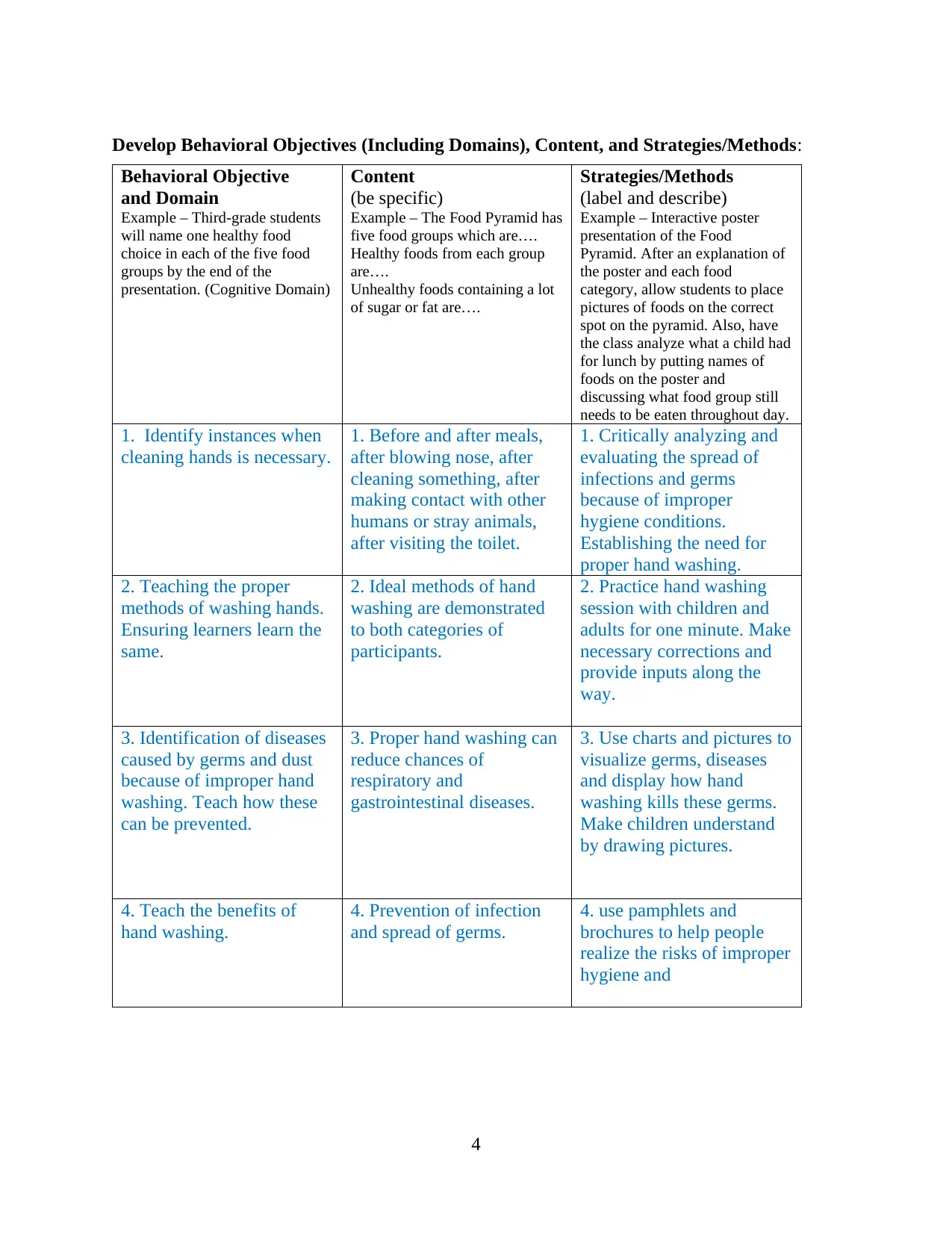
Develop Behavioral Objectives (Including Domains), Content, and Strategies/Methods:
Behavioral Objective
and Domain
Example – Third-grade students
will name one healthy food
choice in each of the five food
groups by the end of the
presentation. (Cognitive Domain)
Content
(be specific)
Example – The Food Pyramid has
five food groups which are….
Healthy foods from each group
are….
Unhealthy foods containing a lot
of sugar or fat are….
Strategies/Methods
(label and describe)
Example – Interactive poster
presentation of the Food
Pyramid. After an explanation of
the poster and each food
category, allow students to place
pictures of foods on the correct
spot on the pyramid. Also, have
the class analyze what a child had
for lunch by putting names of
foods on the poster and
discussing what food group still
needs to be eaten throughout day.
1. Identify instances when
cleaning hands is necessary.
1. Before and after meals,
after blowing nose, after
cleaning something, after
making contact with other
humans or stray animals,
after visiting the toilet.
1. Critically analyzing and
evaluating the spread of
infections and germs
because of improper
hygiene conditions.
Establishing the need for
proper hand washing.
2. Teaching the proper
methods of washing hands.
Ensuring learners learn the
same.
2. Ideal methods of hand
washing are demonstrated
to both categories of
participants.
2. Practice hand washing
session with children and
adults for one minute. Make
necessary corrections and
provide inputs along the
way.
3. Identification of diseases
caused by germs and dust
because of improper hand
washing. Teach how these
can be prevented.
3. Proper hand washing can
reduce chances of
respiratory and
gastrointestinal diseases.
3. Use charts and pictures to
visualize germs, diseases
and display how hand
washing kills these germs.
Make children understand
by drawing pictures.
4. Teach the benefits of
hand washing.
4. Prevention of infection
and spread of germs.
4. use pamphlets and
brochures to help people
realize the risks of improper
hygiene and
4
Behavioral Objective
and Domain
Example – Third-grade students
will name one healthy food
choice in each of the five food
groups by the end of the
presentation. (Cognitive Domain)
Content
(be specific)
Example – The Food Pyramid has
five food groups which are….
Healthy foods from each group
are….
Unhealthy foods containing a lot
of sugar or fat are….
Strategies/Methods
(label and describe)
Example – Interactive poster
presentation of the Food
Pyramid. After an explanation of
the poster and each food
category, allow students to place
pictures of foods on the correct
spot on the pyramid. Also, have
the class analyze what a child had
for lunch by putting names of
foods on the poster and
discussing what food group still
needs to be eaten throughout day.
1. Identify instances when
cleaning hands is necessary.
1. Before and after meals,
after blowing nose, after
cleaning something, after
making contact with other
humans or stray animals,
after visiting the toilet.
1. Critically analyzing and
evaluating the spread of
infections and germs
because of improper
hygiene conditions.
Establishing the need for
proper hand washing.
2. Teaching the proper
methods of washing hands.
Ensuring learners learn the
same.
2. Ideal methods of hand
washing are demonstrated
to both categories of
participants.
2. Practice hand washing
session with children and
adults for one minute. Make
necessary corrections and
provide inputs along the
way.
3. Identification of diseases
caused by germs and dust
because of improper hand
washing. Teach how these
can be prevented.
3. Proper hand washing can
reduce chances of
respiratory and
gastrointestinal diseases.
3. Use charts and pictures to
visualize germs, diseases
and display how hand
washing kills these germs.
Make children understand
by drawing pictures.
4. Teach the benefits of
hand washing.
4. Prevention of infection
and spread of germs.
4. use pamphlets and
brochures to help people
realize the risks of improper
hygiene and
4
Paraphrase This Document
Need a fresh take? Get an instant paraphrase of this document with our AI Paraphraser
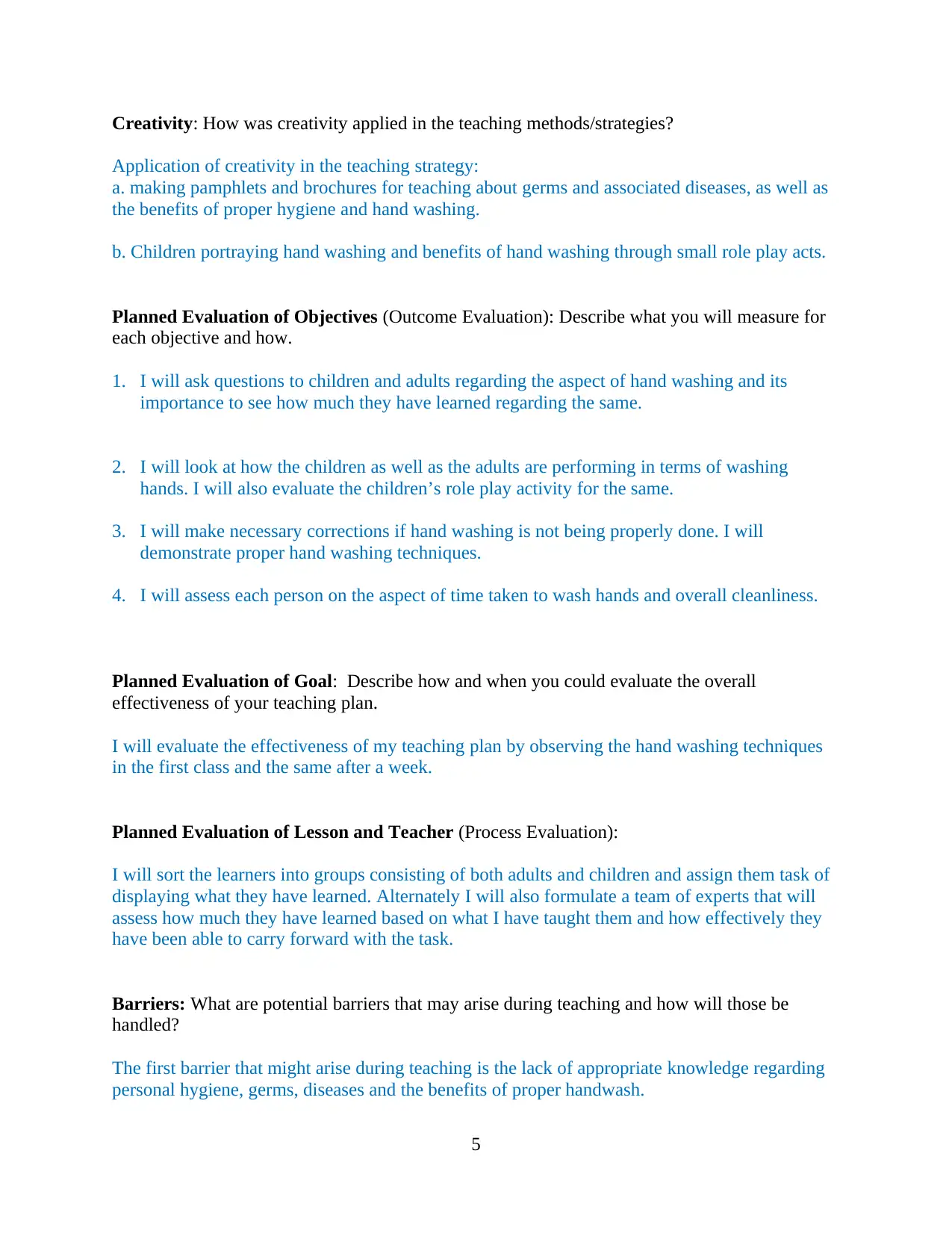
Creativity: How was creativity applied in the teaching methods/strategies?
Application of creativity in the teaching strategy:
a. making pamphlets and brochures for teaching about germs and associated diseases, as well as
the benefits of proper hygiene and hand washing.
b. Children portraying hand washing and benefits of hand washing through small role play acts.
Planned Evaluation of Objectives (Outcome Evaluation): Describe what you will measure for
each objective and how.
1. I will ask questions to children and adults regarding the aspect of hand washing and its
importance to see how much they have learned regarding the same.
2. I will look at how the children as well as the adults are performing in terms of washing
hands. I will also evaluate the children’s role play activity for the same.
3. I will make necessary corrections if hand washing is not being properly done. I will
demonstrate proper hand washing techniques.
4. I will assess each person on the aspect of time taken to wash hands and overall cleanliness.
Planned Evaluation of Goal: Describe how and when you could evaluate the overall
effectiveness of your teaching plan.
I will evaluate the effectiveness of my teaching plan by observing the hand washing techniques
in the first class and the same after a week.
Planned Evaluation of Lesson and Teacher (Process Evaluation):
I will sort the learners into groups consisting of both adults and children and assign them task of
displaying what they have learned. Alternately I will also formulate a team of experts that will
assess how much they have learned based on what I have taught them and how effectively they
have been able to carry forward with the task.
Barriers: What are potential barriers that may arise during teaching and how will those be
handled?
The first barrier that might arise during teaching is the lack of appropriate knowledge regarding
personal hygiene, germs, diseases and the benefits of proper handwash.
5
Application of creativity in the teaching strategy:
a. making pamphlets and brochures for teaching about germs and associated diseases, as well as
the benefits of proper hygiene and hand washing.
b. Children portraying hand washing and benefits of hand washing through small role play acts.
Planned Evaluation of Objectives (Outcome Evaluation): Describe what you will measure for
each objective and how.
1. I will ask questions to children and adults regarding the aspect of hand washing and its
importance to see how much they have learned regarding the same.
2. I will look at how the children as well as the adults are performing in terms of washing
hands. I will also evaluate the children’s role play activity for the same.
3. I will make necessary corrections if hand washing is not being properly done. I will
demonstrate proper hand washing techniques.
4. I will assess each person on the aspect of time taken to wash hands and overall cleanliness.
Planned Evaluation of Goal: Describe how and when you could evaluate the overall
effectiveness of your teaching plan.
I will evaluate the effectiveness of my teaching plan by observing the hand washing techniques
in the first class and the same after a week.
Planned Evaluation of Lesson and Teacher (Process Evaluation):
I will sort the learners into groups consisting of both adults and children and assign them task of
displaying what they have learned. Alternately I will also formulate a team of experts that will
assess how much they have learned based on what I have taught them and how effectively they
have been able to carry forward with the task.
Barriers: What are potential barriers that may arise during teaching and how will those be
handled?
The first barrier that might arise during teaching is the lack of appropriate knowledge regarding
personal hygiene, germs, diseases and the benefits of proper handwash.
5
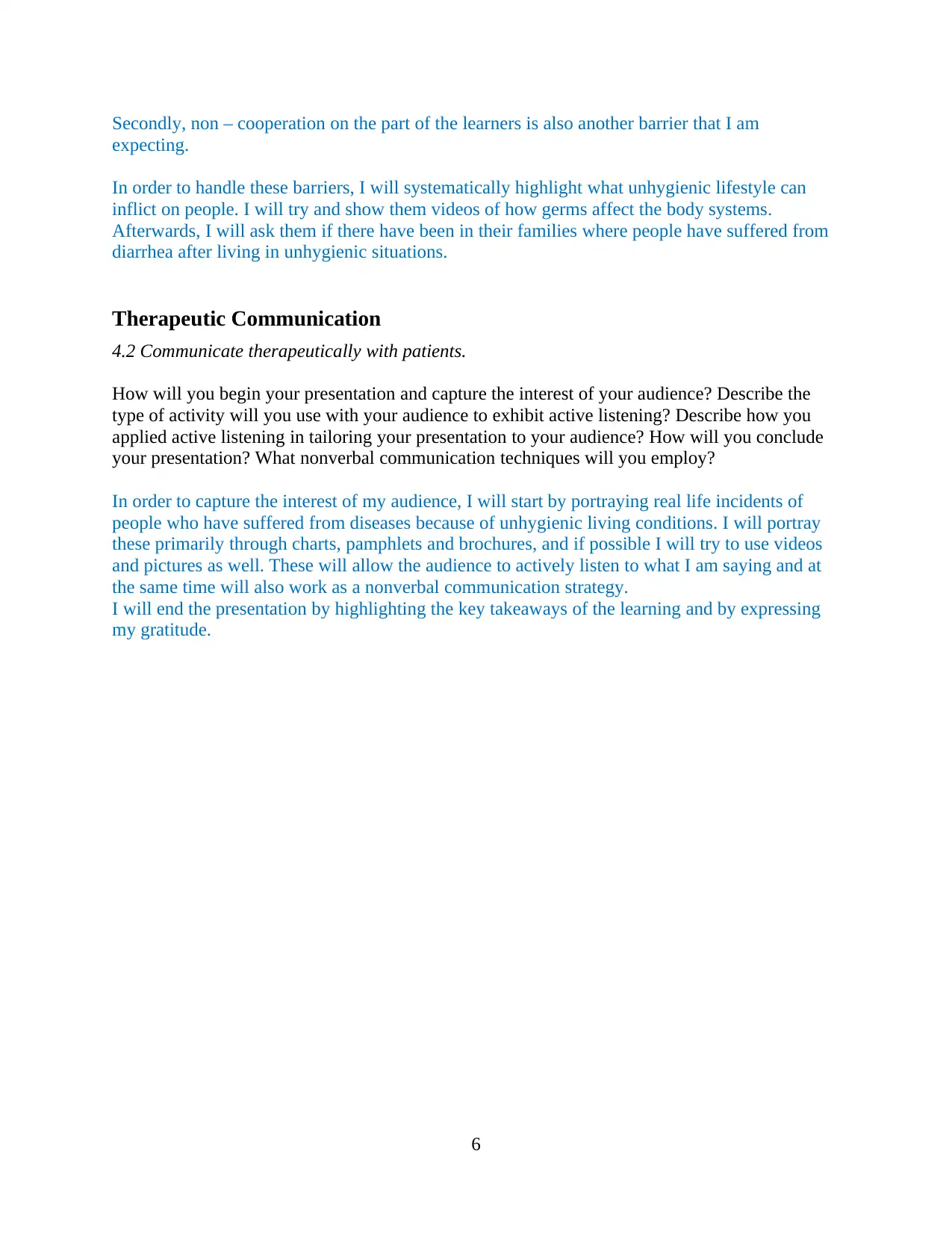
Secondly, non – cooperation on the part of the learners is also another barrier that I am
expecting.
In order to handle these barriers, I will systematically highlight what unhygienic lifestyle can
inflict on people. I will try and show them videos of how germs affect the body systems.
Afterwards, I will ask them if there have been in their families where people have suffered from
diarrhea after living in unhygienic situations.
Therapeutic Communication
4.2 Communicate therapeutically with patients.
How will you begin your presentation and capture the interest of your audience? Describe the
type of activity will you use with your audience to exhibit active listening? Describe how you
applied active listening in tailoring your presentation to your audience? How will you conclude
your presentation? What nonverbal communication techniques will you employ?
In order to capture the interest of my audience, I will start by portraying real life incidents of
people who have suffered from diseases because of unhygienic living conditions. I will portray
these primarily through charts, pamphlets and brochures, and if possible I will try to use videos
and pictures as well. These will allow the audience to actively listen to what I am saying and at
the same time will also work as a nonverbal communication strategy.
I will end the presentation by highlighting the key takeaways of the learning and by expressing
my gratitude.
6
expecting.
In order to handle these barriers, I will systematically highlight what unhygienic lifestyle can
inflict on people. I will try and show them videos of how germs affect the body systems.
Afterwards, I will ask them if there have been in their families where people have suffered from
diarrhea after living in unhygienic situations.
Therapeutic Communication
4.2 Communicate therapeutically with patients.
How will you begin your presentation and capture the interest of your audience? Describe the
type of activity will you use with your audience to exhibit active listening? Describe how you
applied active listening in tailoring your presentation to your audience? How will you conclude
your presentation? What nonverbal communication techniques will you employ?
In order to capture the interest of my audience, I will start by portraying real life incidents of
people who have suffered from diseases because of unhygienic living conditions. I will portray
these primarily through charts, pamphlets and brochures, and if possible I will try to use videos
and pictures as well. These will allow the audience to actively listen to what I am saying and at
the same time will also work as a nonverbal communication strategy.
I will end the presentation by highlighting the key takeaways of the learning and by expressing
my gratitude.
6
⊘ This is a preview!⊘
Do you want full access?
Subscribe today to unlock all pages.

Trusted by 1+ million students worldwide
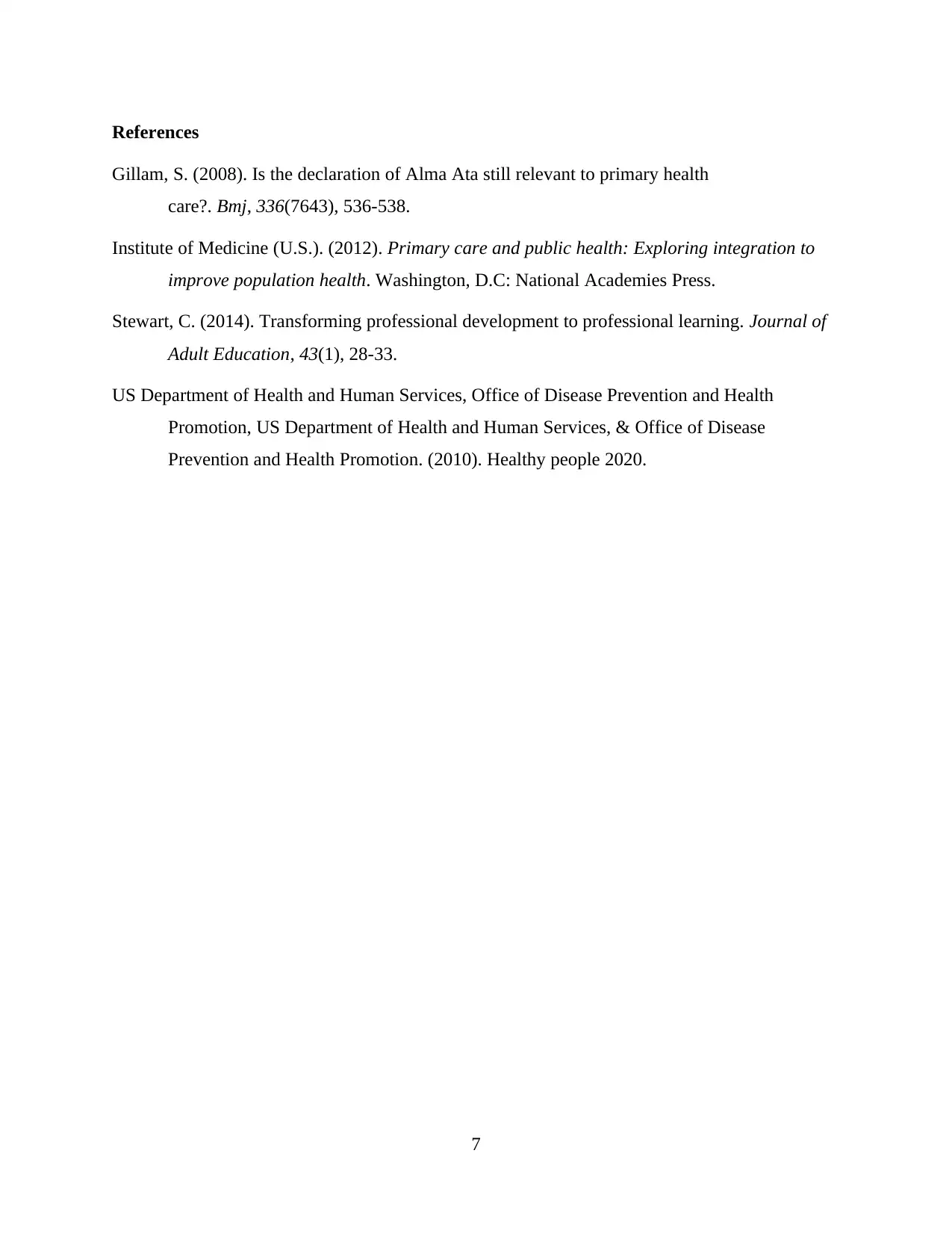
References
Gillam, S. (2008). Is the declaration of Alma Ata still relevant to primary health
care?. Bmj, 336(7643), 536-538.
Institute of Medicine (U.S.). (2012). Primary care and public health: Exploring integration to
improve population health. Washington, D.C: National Academies Press.
Stewart, C. (2014). Transforming professional development to professional learning. Journal of
Adult Education, 43(1), 28-33.
US Department of Health and Human Services, Office of Disease Prevention and Health
Promotion, US Department of Health and Human Services, & Office of Disease
Prevention and Health Promotion. (2010). Healthy people 2020.
7
Gillam, S. (2008). Is the declaration of Alma Ata still relevant to primary health
care?. Bmj, 336(7643), 536-538.
Institute of Medicine (U.S.). (2012). Primary care and public health: Exploring integration to
improve population health. Washington, D.C: National Academies Press.
Stewart, C. (2014). Transforming professional development to professional learning. Journal of
Adult Education, 43(1), 28-33.
US Department of Health and Human Services, Office of Disease Prevention and Health
Promotion, US Department of Health and Human Services, & Office of Disease
Prevention and Health Promotion. (2010). Healthy people 2020.
7
1 out of 7
Related Documents
Your All-in-One AI-Powered Toolkit for Academic Success.
+13062052269
info@desklib.com
Available 24*7 on WhatsApp / Email
![[object Object]](/_next/static/media/star-bottom.7253800d.svg)
Unlock your academic potential
Copyright © 2020–2025 A2Z Services. All Rights Reserved. Developed and managed by ZUCOL.





